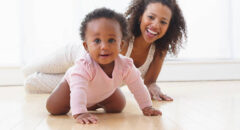
New and expecting parents, has your health provider talked to you about Sudden Infant Death Syndrome? Also known as SIDS, Sudden Infant Death Syndrome is a leading cause of infant mortality. It’s defined as the sudden, unexpected death of an infant (between 1 month and 1 year of age) with no known cause, even after a full investigation into the infant’s death.
Researchers don’t actually know what causes SIDS. It is not caused by an infection that babies “catch,” like the flu. Models have been developed to explain the circumstances that come together to put babies at an increased risk for SIDS, but nothing is definite and there is no way to completely prevent SIDS.
What researchers are certain of is that African American babies continue to die from SIDS at higher rates than white, Hispanic and Asian babies even though the rate of SIDS deaths has declined over the past two decades.
Though the causes of SIDS are uncertain, there are actions that parents, grandparents, and caregivers can take to reduce their baby’s risk of SIDS.
Place your baby to sleep on his or her back. Many of us were raised being put to sleep on our stomachs or sides, but the number one most effective way to reduce your baby’s risk of SIDS is to place the baby on his or her back to sleep - not only at night but also for naptime. Your baby may roll over while sleeping, but the most important thing is that he or she starts on the back.
Use a firm, flat sleep surface and remove loose bedding and blankets. Additional blankets and bedding may appear to be comfortable for babies, but they increase your baby’s risk for SIDS as well as suffocation and strangulation.
Share your room with your baby, but not your bed. The American Academy of Pediatrics recommends that babies sleep on a separate surface for your baby’s first year and if that isn’t possible then at least for his or her first six months.
Ensure your baby doesn’t get too hot during sleep. To prevent your baby from becoming too hot and to eliminate the need for loose bedding, dress your baby in a wearable blanket. Be sure not to overdress your baby or cover his or her face while sleeping.
You can learn more about creating a safe sleeping environment for your baby on the Safe to Sleep® campaign website.

Jasmine Berry, B.A. in Journalism is a graduate of Hampton University and is soon to have her master of public health from Tulane University. She loves all things mental wellness and a good cup of tea.








